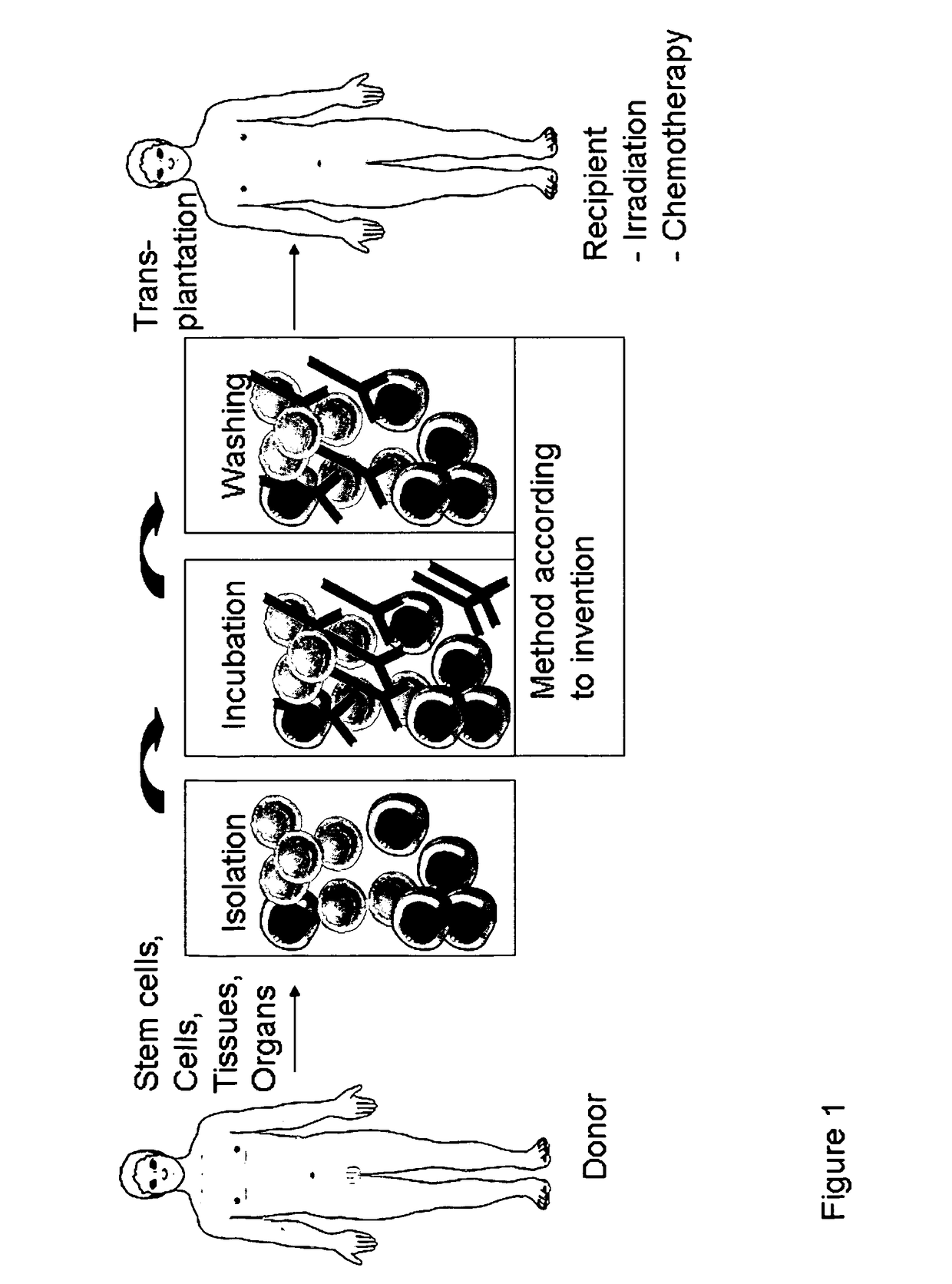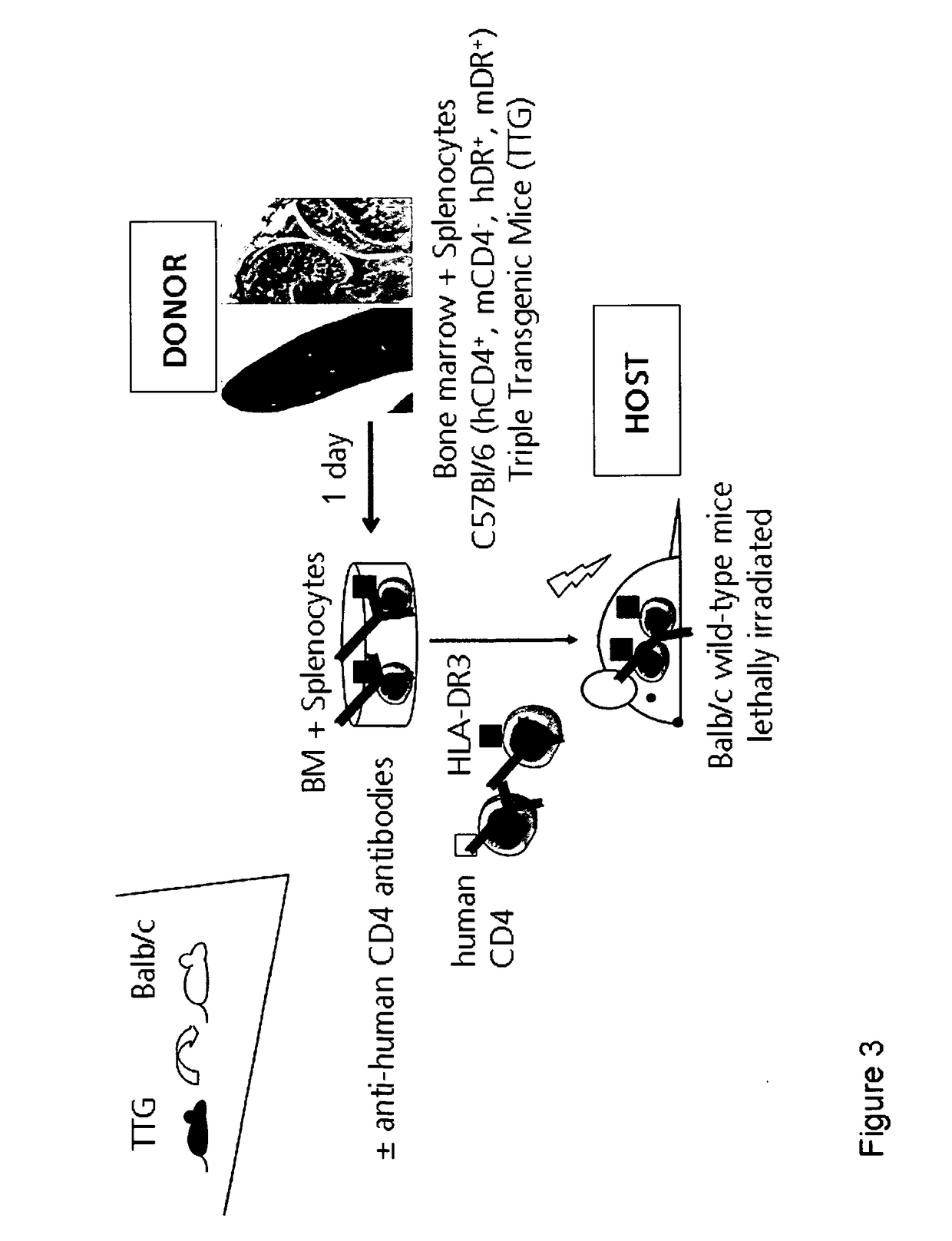Anti CD4 antibodies to prevent in particular graft-versus-host-disease (GvHD)
a technology of graft-versus-host disease and anti-cd4 antibodies, which is applied in the field of anti-cd4 antibodies to prevent in particular graft-versus-host disease (gvhd), can solve the problems of limited use of monoclonal antibodies in clinical applications, antibody medical ingredients, and significant mortality of hsct patients
- Summary
- Abstract
- Description
- Claims
- Application Information
AI Technical Summary
Problems solved by technology
Method used
Image
Examples
example 1
Animals
[0307]Donor C57B1 / 6 CD4k / o mice, C57B1 / 6 wild-type mice and recipient Balb / c wild-type mice were bred at the Animal Facility at the University of Leipzig. The mice strain was maintained under standardized conditions. The C57B1 / 6 CD4k / o mice have a stable C57B1 / 6 background, in which the murine CD4 molecule is knocked out and express a human CD4. The CD4 transgene includes its own promoter ligated to a murine CD4 enhancer element thus leading to T cell subset-specific expression. CD8+ cells are not affected in TTG mice. Furthermore, these mice express the HLA-DR3 molecule in addition to the murine MHC II complex. The TTG mice have complete functional murine immune system which is modified with regard to CD4 and HLA-DR. The mice were fed ad libitum. As donors, C57B1 / 6 and Balb / c mice were purchased from Charles River (Sulzfeld, Germany; http: / / jaxmice.jax.org).
[0308]All mice were housed, treated or handled in accordance with the guidelines of the University of Leipzig Animal Ca...
example 2
[0320]Recombinant DNA techniques were performed using methods well known in the art and, as appropriate, supplier instructions for use of enzymes used in these methods. Sources of general methods included standard literature such as well-known books edited by Sambrook and Russel and by Ausubel. Detailed laboratory methods are also described below. In silico methods such as those described in WO9859244 were used to analyze the variable heavy and light chain sequences of mouse anti-CD4 for peptides predicted to bind to MHC Class II molecules (these were considered as T cell epitopes).
example 2a
nti-CD4 Antibody
[0321]mRNA was extracted from the mouse anti-CD4 hybridoma cells using a Poly A Tract System 1000 mRNA extraction kit: (Promega Corp. Madison Wis.) according to manufacturer's instructions. mRNA was reverse transcribed as follows: For the kappa light chain, 5.0 microliter of mRNA was mixed with 1.0 microliter of 20 pmol / microliter MuIgκVL-3′ primer OL040 (Table 2) and 5.5 microliter nuclease free water (Promega Corp. Madison Wis.). For the lambda light chain, 5.0 microliter of mRNA was mixed with 1.0 microliter of 20 pmol / microliter MuIgκVL-3′ primer OL042 (Table 2) and 5.5 microliter nuclease free water (Promega Corp. Madison Wis.). For the gamma heavy chain, 5 microliter of mRNA was mixed with 1.0 microliter of 20 pmol / microliter MuIgVH-3′ primer OL023 (Table 1) and 5.5 microliter nuclease free water (Promega Corp. Madison Wis.). All three reaction mixes were placed in the pre-heated block of the thermal cycler set at 70° C. for 5 minutes. These were chilled on ice...
PUM
| Property | Measurement | Unit |
|---|---|---|
| molecular weight | aaaaa | aaaaa |
| concentration | aaaaa | aaaaa |
| concentration | aaaaa | aaaaa |
Abstract
Description
Claims
Application Information
 Login to View More
Login to View More - R&D
- Intellectual Property
- Life Sciences
- Materials
- Tech Scout
- Unparalleled Data Quality
- Higher Quality Content
- 60% Fewer Hallucinations
Browse by: Latest US Patents, China's latest patents, Technical Efficacy Thesaurus, Application Domain, Technology Topic, Popular Technical Reports.
© 2025 PatSnap. All rights reserved.Legal|Privacy policy|Modern Slavery Act Transparency Statement|Sitemap|About US| Contact US: help@patsnap.com



